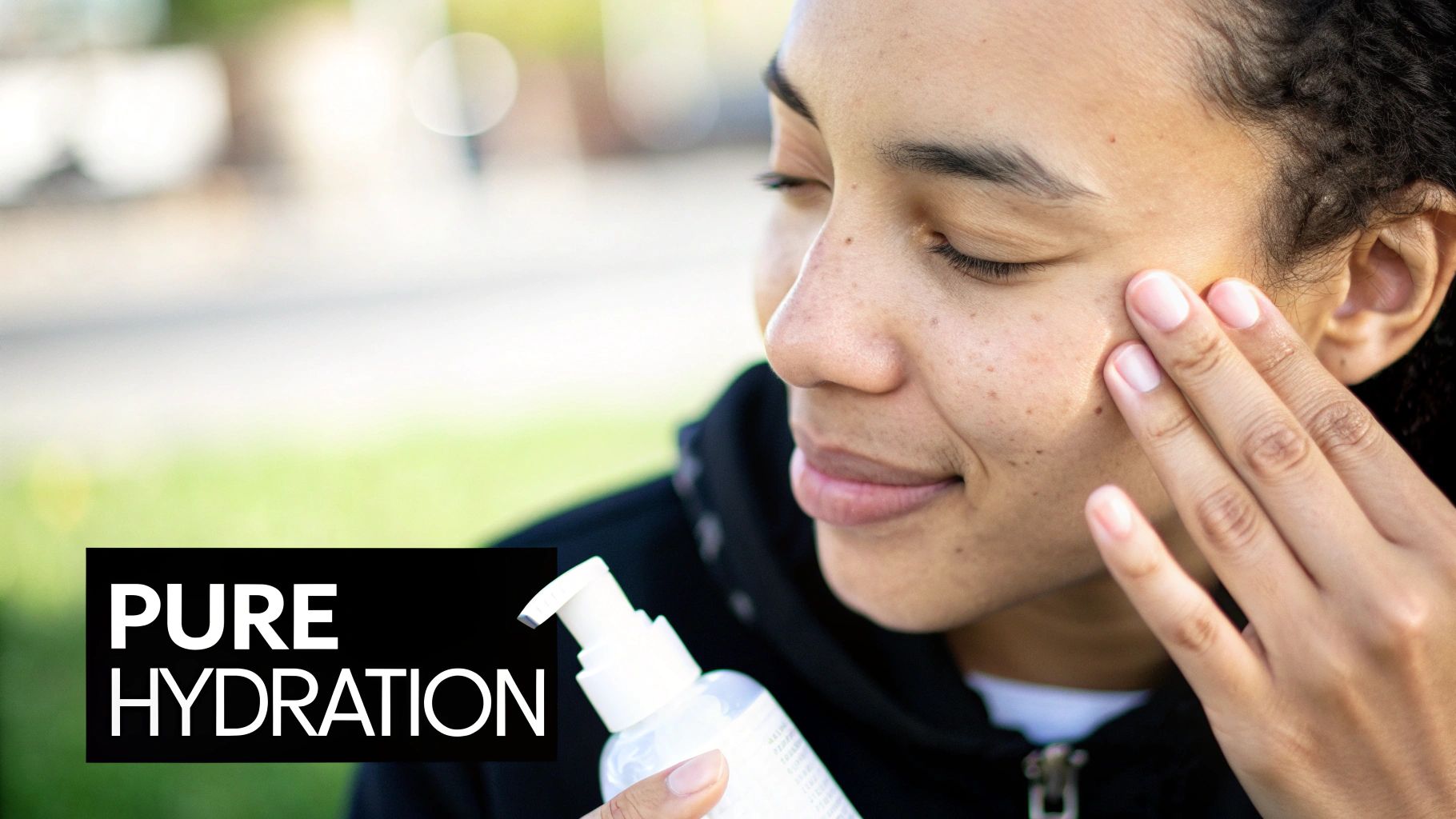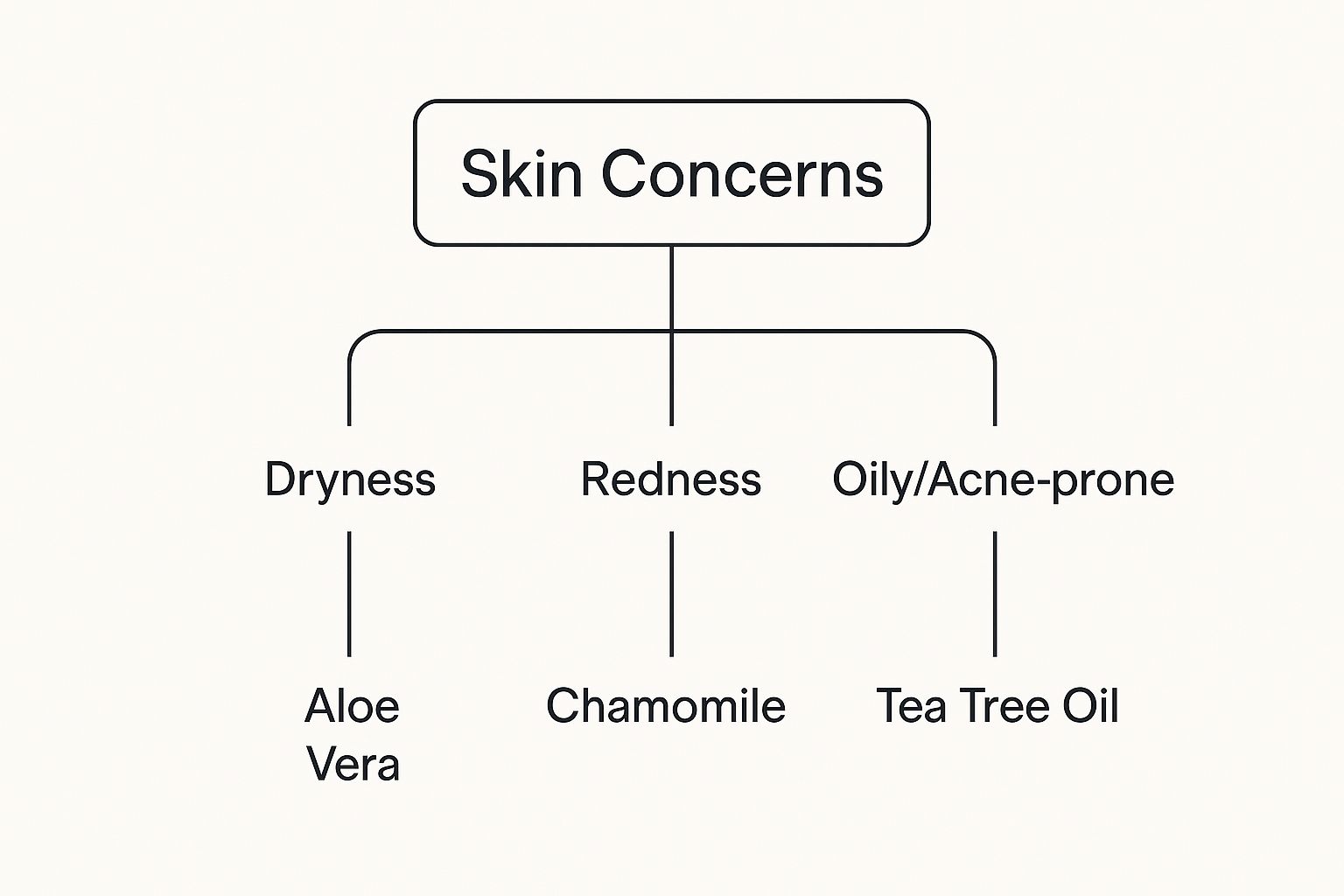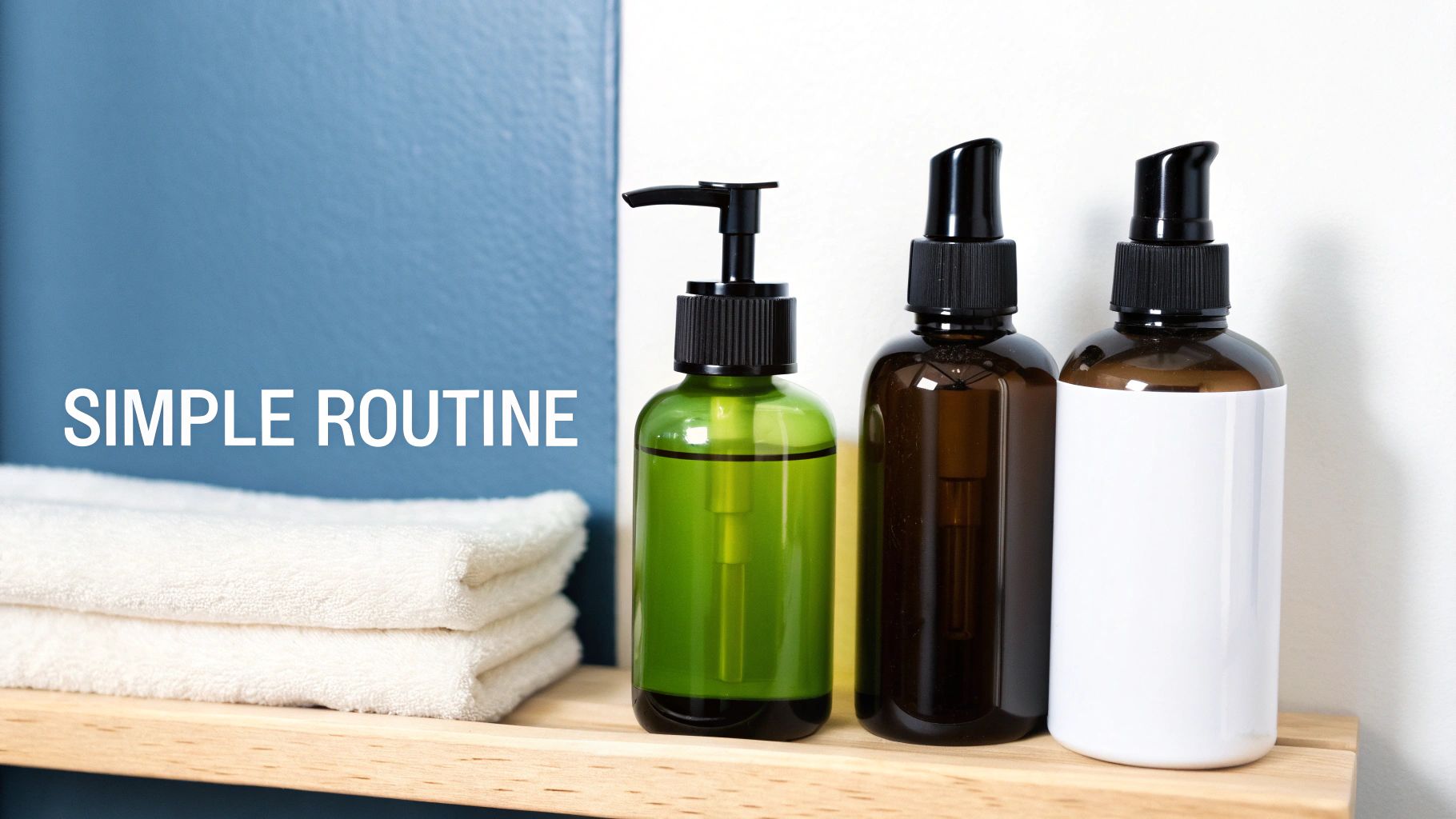Jan Elvis
13.10.2025

Jan Elvis
13.10.2025
Skincare routines can feel way too complicated. The truth is, you don't need a ten-step process to get healthy skin. Making one simple change—switching to a chemical free face moisturizer—can make a massive difference by giving your skin the good stuff, without any of the junk. It's an easy swap that cuts out the guesswork and gets you visible results.

Let's be real. You want your skin to look and feel good, but you don't want a routine that takes forever. Moving to a natural moisturizer is probably the single most impactful upgrade you can make for your skin's health, both now and down the road.
Think of it like this: your skin is like a car engine. You wouldn't put cheap, dirty fuel in a high-performance machine, right? Natural, high-quality ingredients are the premium fuel that keeps your skin running smoothly. In contrast, many of the synthetic chemicals in standard moisturizers can gunk up the works, causing irritation, breakouts, and other issues.
First things first, let's clear something up. When we say "chemical free," we're not being literal—everything, even water, is a chemical. In the skincare world, this is just shorthand for products that ditch the harsh, synthetic ingredients that often do more harm than good.
We're talking about avoiding the main offenders, like:
One study pointed to fragrance as a major red flag on ingredient labels. Simply choosing products that are fragrance-free is an easy win to dodge a mix of potentially irritating chemicals and keep your skin happy.
When you opt for a moisturizer that skips these additives, you're giving your skin pure hydration and nourishment. This simple switch directly helps with common problems like redness, flaky patches, and general sensitivity, letting your skin breathe and rebuild. It's all about working with your skin's natural system, not fighting against it.

Let's get one thing straight: the term "chemical free" is a bit of a marketing shortcut. From a purely scientific standpoint, everything is a chemical—even the water you drink. But in the skincare aisle, it means something different. It's code for products that steer clear of the harsh, synthetic stuff that can mess with your skin.
Think of it like this: you can eat a fresh apple or a snack cake full of weird preservatives and artificial colors. Both are food, but one nourishes your body while the other just fills a hole. A chemical-free face moisturizer is the fresh apple for your skin, packed with ingredients it can actually use, not just fillers and junk.
You don't need a chemistry degree to buy a good moisturizer, but you do need to become a savvy label reader. Your mission is to spot the common red flags that tell you a product isn't as clean as it claims.
Keep an eye out for these main offenders:
For a deeper dive into why this matters, check out our guide on the benefits of natural skin care products for men.
Choosing a moisturizer without these ingredients isn't about being paranoid. It's about giving your skin clean fuel instead of questionable additives that can cause problems down the road.
This isn’t just a niche trend, either. The global organic skincare market was valued at USD 12.57 billion and is expected to more than double by 2033. That boom is being driven by guys who are tired of putting mystery chemicals on their faces.
Part of being a smart consumer is understanding harmful substances like PFAS and other sneaky additives that can find their way into products. Once you know what to look for, you'll never see that ingredient list the same way again.
When you're picking a chemical free face moisturizer, the real win isn't about the brand name on the bottle—it's about the ingredients inside. Instead of getting bogged down by a long, confusing list, focus on matching powerful, natural ingredients to what your skin actually needs. It's like building a custom toolkit for your face.
This simple shift makes everything easier. You're no longer guessing. You're directly targeting your biggest issue, whether that's stubborn dryness, blotchy redness, or an oily T-zone that shines a little too bright by lunchtime. Once you know which ingredients tackle which problems, you can glance at any product label and know instantly if it's right for you.
Does your skin feel tight, flaky, or just plain thirsty all the time? You need ingredients that are masters of hydration and repair. The goal is to find stuff that doesn't just add moisture, but actually helps your skin lock it in for the long haul.
If you're dealing with oily skin or breakouts, your mission is all about balance. The last thing you want to do is strip your skin of all its oil—that just makes it angry and causes it to produce even more.
The biggest mistake you can make with oily skin is trying to dry it out completely. This often backfires, causing your skin to produce even more oil to compensate. The goal is to work with your skin to find a healthy equilibrium.
The right ingredients can help regulate oil production and keep your pores clear without all that harshness.

As the infographic shows, it’s all about finding the right natural solution for your specific issue. For oily skin, that means ingredients like jojoba oil. It's brilliant because its molecular structure is incredibly similar to your skin’s own natural oil (sebum), which basically tricks your skin into calming down and producing less of it.
Another great one is tea tree oil, a natural powerhouse that fights acne-causing bacteria without the burn of synthetic chemicals. Gaining a solid grasp of understanding natural oils can be a game-changer for your entire grooming routine.
To make it even simpler, here's a quick cheat sheet to help you connect your skin's needs with the right natural solutions.
This table is a quick-reference guide to matching powerful, natural ingredients with specific skin concerns and types, helping you find the perfect chemical-free formulation.
| Skin Type / Concern | Best Natural Ingredients | What It Does |
|---|---|---|
| Dry / Dehydrated | Aloe Vera, Shea Butter, Hyaluronic Acid | Delivers deep hydration and helps the skin retain moisture. |
| Oily / Combination | Jojoba Oil, Grapeseed Oil, Witch Hazel | Balances oil production and helps minimize the appearance of pores. |
| Acne-Prone | Tea Tree Oil, Salicylic Acid (from Willow Bark) | Fights bacteria, reduces inflammation, and keeps pores clear. |
| Sensitive / Red | Chamomile, Calendula, Green Tea Extract | Soothes irritation, calms redness, and provides antioxidant protection. |
By keeping these ingredients in mind, you can cut through the marketing noise and choose a moisturizer that genuinely works for you.
Alright, now that you know what to avoid and which natural ingredients are legit, let's get down to business. It's time to put that knowledge to work and actually find the right chemical-free face moisturizer for you. This isn't about just grabbing the first thing you see; it's about making a smart choice for your skin.
The most critical first step? Knowing your skin type. Seriously, if you skip this, you're just guessing. Not sure if you're oily, dry, or something in between? No sweat, it's easy to figure out. For a simple guide, check out our article on how you can tell your skin type.
Once you've got your skin type pinned down, finding the right product gets a whole lot easier. The trick is to match the moisturizer's ingredients and feel to what your skin is crying out for.
Here’s a quick rundown:
Oily or Acne-Prone Skin: Your goal is hydration without the extra shine. Look for lightweight lotions or gels that soak in fast. The term "non-comedogenic" should be your new best friend—it just means the formula won't clog your pores.
Dry or Flaky Skin: Your skin is thirsty, plain and simple. You'll want a richer cream or even a balm to quench it. Ingredients like shea butter and plant-based hyaluronic acid are amazing for deep hydration and helping to fix your skin's natural barrier.
Combination Skin: Welcome to the club. With both oily and dry patches, you need to find a balance. A light-to-medium lotion is usually the sweet spot. You can apply a bit more on the dry parts and go lighter on your T-zone (forehead, nose, and chin).
Sensitive Skin: Keep it simple. Look for formulas with soothing ingredients like aloe or chamomile. And always hunt for "fragrance-free" on the label, which is different from "unscented," to make sure you’re avoiding sneaky irritants.
People are wising up and demanding cleaner, safer skincare. It's not a niche thing anymore—North America now makes up over 40% of the entire global facial moisturizer market, largely because guys like you are saying no to sulfates and parabens.
Here’s a pro tip that can save you a ton of grief. Even with all-natural ingredients, your skin can still have a bad reaction. So before you go all-in on a new moisturizer, do a quick patch test.
Dab a small amount on a spot that's out of the way, like behind your ear or on the inside of your wrist. Wait a full 24 hours. If you see no redness or feel any irritation, you’re good to go. It’s a simple step, but it’s a game-changer.

Switching up your skincare routine shouldn't be a big deal. Moving to a chemical free face moisturizer is one of the easiest and most impactful upgrades you can make, but it helps to know what to expect so the transition is smooth.
Your skin might need a little time to get used to the new, cleaner formula. You might even experience a brief "skin purge" where some underlying gunk comes to the surface. Don't sweat it. Think of it as your skin finally getting a chance to detox from all the synthetic stuff, and it's a great sign that the natural ingredients are already getting to work.
The secret to great skin isn't some 10-step, complicated ritual. It’s all about consistency with the basics. Nailing this simple foundation is all you need to keep your skin looking and feeling its best.
If you're looking to build out a full routine from scratch, our complete skincare routine for beginners has you covered.
The biggest rookie mistake? Slapping moisturizer onto a completely dry face. Applying it to damp skin is a total game-changer—it acts like a sponge, pulling that water deep into your skin for hydration that actually lasts.
This shift to cleaner products isn't just about you; it's a massive trend. People are getting smarter about what they put on their skin, and the industry is finally catching up. In fact, over 59% of consumers say they prefer natural skincare, and 54% are now actively checking ingredient lists before they buy. That's a huge shift, and it’s forcing brands to clean up their act.
Stepping into the world of natural skincare can feel like learning a new language. Let's clear up some of the most common questions guys have when they're looking for a solid chemical-free face moisturizer.
Yeah, they often do—and that’s a feature, not a bug. Think about it: a moisturizer without a bunch of synthetic preservatives like parabens isn't engineered to survive a zombie apocalypse on a shelf. It's made with fresher stuff.
Most natural products rely on things like vitamin E or rosemary extract to stay fresh, which usually gives them a shelf life of about 6 to 12 months after you crack them open. It's the difference between a fresh loaf of bread from a bakery and a packaged snack cake. Just look for the little open jar symbol on the packaging (it's called a PAO, or period-after-opening) to see how long it's good for.
Not necessarily. It's a common misconception that if an ingredient grows on a plant, it can't possibly irritate your skin. While you're dodging a lot of harsh synthetic chemicals, some guys can still react to natural ingredients, especially things like essential oils from citrus fruits.
This is why the patch test is your best friend. Seriously, don't skip it. Dab a little bit of the new product on the inside of your wrist or just behind your ear. Give it 24 hours. If your skin looks calm, you're good to go. It's a simple move that can save you from a major red-faced disaster.
In a market flooded with options, authenticity really boils down to transparency. A brand that's worth your money won't hide what's in its products. Look for companies that proudly display their full ingredient lists and even explain what each one does.
Another great sign is when a brand goes the extra mile for third-party certifications. Seals like USDA Organic, EWG Verified, or the Leaping Bunny (for cruelty-free) show they're not just talking the talk.
A brand that takes the time to educate you is a brand that believes in what they're selling. If they're using vague terms like "fragrance" or "proprietary blend" to hide what's inside, that's a red flag.
Ready to find a moisturizer that actually works for you without any of the junk? Main Character is all about clean, effective skincare that helps you put your best face forward. Check out our lineup and upgrade your routine today at https://www.dontlooktrash.com.